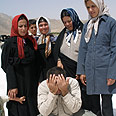
The Islamic Revolution in Iran caused a retreat in the status of women in that country, pushing them to the social and cultural peripheries and placing them in literal and metaphorical hiding behind their curtain of veils.
Moreover, at the end of the 80’s when the new wave of personal, realistic-poetic, socially conscious and humanistic film was at its height, women fought to play active roles as actresses and directors who desired to express their views, troubles and aspirations.
Cinematic activity by women within the religiously, culturally and manly ideology was made partially possible by the adoption of a complex system of modesty rules which befell the entire movie industry.
There were Muslim codes regarding appearance, honorable behavior, modest acting and directing and the goal was to dismember the connection between women’s appearance in public and the connotations of a lack of ethicality and violence and pornography which were associated with film during the period of the Shah.
Maintenance of the limiting codes underwent a gradual liberalization process which developed in three stages; from a situation in which women were absent in film and until the prominent presence of women and their participation in all the cinematic creation processes.
The first phase was characterized by the concealment of veil-less and robe-less female characters from foreign and Iranian movies alike.
Prohibited parts were shortened, erased or blurred by means of official censors or those instilled personally by the directors.
In the second phase, women did appear on the big screen but as “ghosts;” secondary characters in the background, in passive roles and not as central characters able to spark or assist in developing the story.
Simultaneously, aesthetics and grammatical rules were developed which were based on gender and separation between the sexes and which determined rules regarding dress covering the entire body, prohibition of touch between the sexes and prevention of cross-gender eye contact.
The third phase in the 80’s occurred during a period of relative liberalization and allowed women to be shown as characters on the screen and to reach greater independence as film producers themselves.
Women directors protest male norms
They attained more revealing screen time, exposure of their faces, their expressions and more dramatic appearances in central roles.Instead of endangering, ignorant, helpless, submissive women used as objects by men, active women with personalities and desires began appearing.
Women directors started using film in order to asses their lives and problems in a critical fashion and make heard their protest against male norms.
One such film will be presented by the Israel Women’s Network and the International Women’s Film Festival as part of the one-week female movie celebrations to be held in Rehovot starting September 15.
The documentary Iranian film is entitled “Four Wives, One Man” (2008) and is directed by female director Nahid Persson.
The movie gives a detailed and concrete account of the lives and hopeless, dead-ended status of village women who are caught in a trap of polygamy and economic dependence on a breadwinning man.















